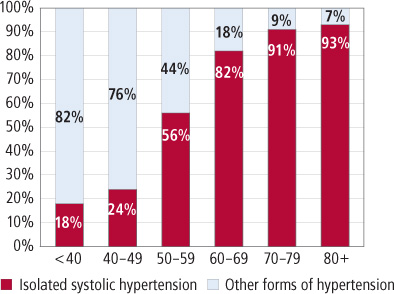Isolated systolic high blood pressure

Remember that the systolic blood pressure is the top number in the blood pressure reading and represents the pressure in the arteries as the heart contracts and pumps blood into the arteries. A systolic blood pressure that is persistently higher than 140 mm Hg is usually considered elevated, especially when associated with an elevated diastolic pressure (over 90).
Isolated systolic hypertension, however, is defined as a systolic pressure that is above 140 mm Hg with a diastolic pressure that still is below 90. This disorder primarily affects older people and is characterized by an increased (wide) pulse pressure. The pulse pressure is the difference between the systolic and diastolic blood pressures. An elevation of the systolic pressure without an elevation of the diastolic pressure, as in isolated systolic hypertension, therefore, increases the pulse pressure. Stiffening of the arteries contributes to this widening of the pulse pressure.
Once considered to be harmless, a high pulse pressure is now considered an important precursor or indicator of health problems and potential end-organ damage. Isolated systolic hypertension is associated with a two to four times increased future risk of an enlarged heart, a heart attack
(myocardial infarction), a stroke (brain damage), and death from heart disease or a stroke. Clinical studies in patients with isolated systolic hypertension have indicated that a reduction in systolic blood pressure by at least 20 mm to a level below 160 mm Hg reduces these increased risks.




0 comments:
Post a Comment